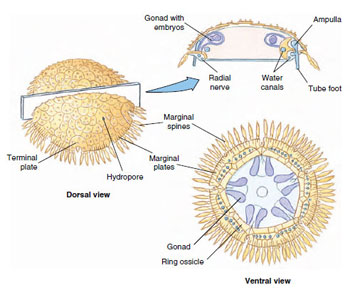Class Concentricycloidea
Class
Concentricycloidea
Strange little (less than 1 cm diameter), disc-shaped animals (Figure 23-27) were discovered in water over 1000 m deep off New Zealand. Sometimes called sea daisies, they are the most recently described (1986) class of echinoderms, and only two species are known so far. They are pentaradial in symmetry but have no arms. Their tube feet are located around the periphery of the disc, rather than along ambulacral areas, as in other echinoderms. Their water-vascular system includes two concentric ring canals; the outer ring may represent radial canals since podia arise from it. A hydropore, homologous to the madreporite, connects the inner ring canal to the aboral surface. One species has no digestive tract; its oral surface is covered by a membranous velum, by which it apparently absorbs nutrients. The other species has a shallow, saclike stomach but no intestine or anus.
Strange little (less than 1 cm diameter), disc-shaped animals (Figure 23-27) were discovered in water over 1000 m deep off New Zealand. Sometimes called sea daisies, they are the most recently described (1986) class of echinoderms, and only two species are known so far. They are pentaradial in symmetry but have no arms. Their tube feet are located around the periphery of the disc, rather than along ambulacral areas, as in other echinoderms. Their water-vascular system includes two concentric ring canals; the outer ring may represent radial canals since podia arise from it. A hydropore, homologous to the madreporite, connects the inner ring canal to the aboral surface. One species has no digestive tract; its oral surface is covered by a membranous velum, by which it apparently absorbs nutrients. The other species has a shallow, saclike stomach but no intestine or anus.
 |
 |
| Figure 23-27 Xyloplax spp. (class Concentricycloidea) are bizarre little disc-shaped echinoderms. With their podia around the margin, they are the only echinoderms not having podia distributed along ambulacral areas. |
Figure 23-28 A, Dendrocystites, a carpoid (subphylum Homalozoa) with one brachiole. Brachioles are so called to distinguish them from the heavier arms of asteroids, ophiuroids and crinoids. This group bore some characters interpreted as chordate in nature. It is called Calcichordata by some investigators. B, Helicoplacus, a helicoplacoid, had three ambulacral areas and apparently a water-vascular system. It is the sister group to modern echinoderms. |




